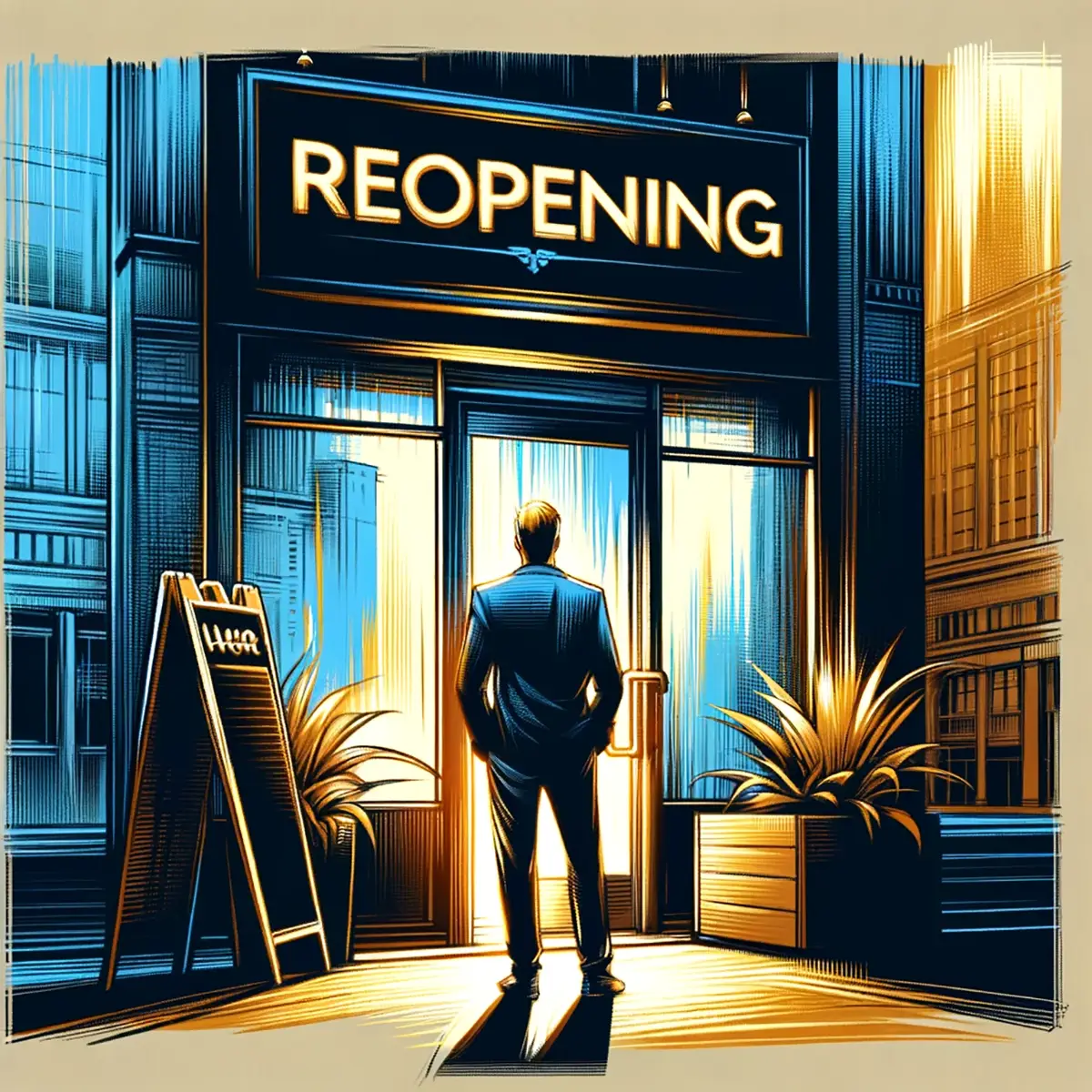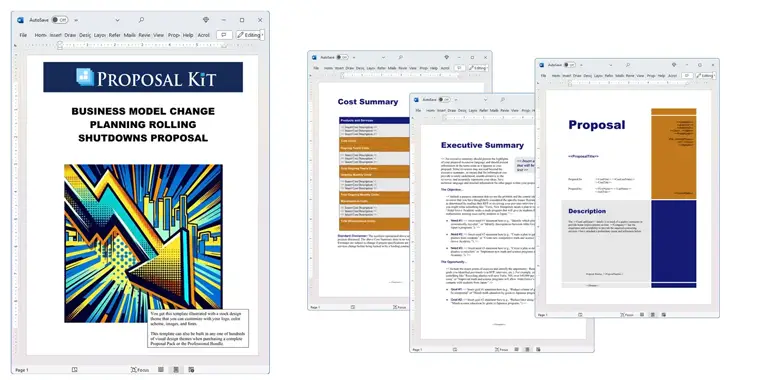How to write your Business Model Change Planning Rolling Shutdowns Proposal
We include this 21 page layout with every Proposal Pack. If you want this template to have a different visual design theme than the one illustrated here, purchase any Proposal Pack design and create this template using the purchased design theme. This template is included in every Proposal Pack. If you get a Proposal Pack or the Professional Bundle, you can also make any variation of this template with different chapters to suit your needs.
We typically include more chapters in the templates than most people will need to give everyone more variety in the chapters they may need. You can trim down a long template by removing pages you do not need or combining multiple chapter topics into one page.
 DOWNLOADABLE, ONE-TIME COST, NO SUBSCRIPTION FEES
DOWNLOADABLE, ONE-TIME COST, NO SUBSCRIPTION FEES If you need this template on DVD media order from our Amazon shop.
If you need this template on DVD media order from our Amazon shop.
You can also create countless variations of this document to suit your needs using the included library of 2200+ chapters if ordering a Proposal Pack or Pro Bundle.
 What Our Clients Say
What Our Clients SayI have been using this fantastic business tool for over three years now, It has provided me with everything to keep up with timely submission of very important proposals and most importantly keep me on top of deadlines."
Euan, Inc.
Related Article
Related Video
Related Templates
- Business Continuity Services Proposal
- Succession Planning Proposal
- Business Plan to Restart Shuttered Business
- IT Disaster Recovery Services Proposal
- Bankruptcy and Foreclosure Crisis Report
- Failing Business Turnaround Proposal
- Strategic Plan
- Technology Strategy Analysis
- Downsizing Company Cost Savings Proposal
- Strategic Plan for Mobilization and Deployment of Project
- Strategic Business Plan
- Strategic Business Map
Business Model Changes for Rolling Shutdowns with Proposal Kit
In the wake of the unexpected difficulties in the economy, businesses face unprecedented challenges, one of which is adapting their business models to accommodate rolling or wave-based shutdowns to try and survive a downturn. This adaptation can be crucial for managing finances, staffing levels, and inventory in response to fluctuating operational demands. For many, the task of drafting a business proposal for such a significant change can be daunting, especially for those unfamiliar with the process. This article delves into how to write a business model change proposal for rolling shutdowns, using the Proposal Kit template library and Wizard software program.
Have you found yourself in a situation where your business needs to adapt its model to manage rolling shutdowns effectively?
Writing a Business Model Change Proposal
The most effective way to write a business model change proposal is by utilizing the structured approach offered by Proposal Kit. This software aids users in writing a proposal that addresses the specific challenges and requirements of managing rolling shutdowns. The Proposal Kit includes a variety of templates and a line item quoting database system for creating detailed cost summaries, financial estimates, and budgets. This integration ensures a comprehensive and financially sound proposal.
What Types of Projects Are Business Model Change Planning Rolling Shutdown Proposals Written For?
When planning for rolling shutdowns, businesses might undertake various projects, including:
- Temporary closure plans
- Staff rotation and furlough schemes
- Inventory management during shutdowns
- Financial reserve allocation
- Ramp-up strategies for reopening phases
- Digital transformation for remote operations
- Supply chain adjustments for fluctuating demand
- Emergency fund creation
- Employee training for new operational models
- Risk management and contingency planning
Chapters this template is built with
Proposal Kit's templates can be instrumental in writing a proposal for business model changes. The Proposal Kit template library includes thousands of topics to outline everything you need to cover in your proposal. Some templates related to this situation are outlined below.
Each of these components plays a critical role in constructing a comprehensive and effective business proposal. They work together to present a clear, organized, and pragmatic approach to adapting a business model in response to the challenges of rolling shutdowns.
Executive Summary
This section is a concise overview of the entire proposal, highlighting the necessity for a business model change in the face of rolling shutdowns. It should clearly state the objectives and the anticipated outcomes, setting the stage for what the reader can expect in the detailed proposal. This summary is crucial as it provides a snapshot of the proposed changes and their intended impact on the business.
Starting Up
This part outlines the initial steps required to transition to the new business model. It includes timelines, key activities, and the allocation of resources necessary for the initial phase. This section sets the foundation for the business model change, ensuring that the transition begins on a structured and well-planned note.
Reductions
Here, the proposal details strategies for reducing operational costs, managing inventory levels, and potentially reducing staff during shutdown periods. It should provide a clear plan on how these reductions will be implemented, ensuring minimal impact on the business's overall functionality and employee morale.
Resource Allocation
This section explains how resources, including finances, manpower, and materials, will be distributed throughout the different phases of the business cycle. It ensures that resources are used efficiently and effectively, especially during periods of reduced operation.
Staffing
This part discusses strategies for managing the workforce during rolling shutdowns, including staff rotation schedules, furloughs, and training programs for employees to adapt to new operations. It addresses how staffing changes will be communicated and managed humanely and effectively.
Replenishment
Plans for restocking and ramping up operations post-shutdown are outlined in this section. It includes strategies for efficiently resuming full operations, restocking inventory, and mobilizing the workforce as the business returns to normalcy.
Risk Management
Identifies potential risks associated with rolling shutdowns and the new business model. This section should propose mitigation strategies to manage these risks, ensuring the business is prepared for various scenarios.
Contingency Planning
Focuses on preparing for unexpected challenges and scenarios during shutdowns. This includes backup plans, emergency procedures, and alternative strategies to keep the business running smoothly in the face of unforeseen events.
Safety Net
Establishes protocols and measures to protect employees' welfare and the business's interests during transitional periods. This could include financial safety nets, employee support programs, and other protective measures.
Shortages and Reserves
Deals with managing inventory shortages and maintaining financial reserves. This section outlines how the business will handle potential supply chain disruptions and financial constraints, ensuring stability during uncertain times.
Budget
Presents a detailed financial plan for the proposed changes, including projected costs, potential savings, and investment requirements. This budget should be realistic and consider all financial aspects of the business model change.
Company Operations
Describes how daily operations will be altered under the new business model. This includes changes in work processes, operational hours, customer service approaches, and other routine business activities.
Business Model
Provides an in-depth explanation of the new business model structure. This should include how the model is adapted to rolling shutdowns, its long-term sustainability, and how it aligns with the company's overall strategic goals.
Use cases for this template
Jordan's Restaurant Resilience Plan
Jordan, the owner of a beloved local restaurant, found himself at a crossroads when faced with the unpredictability of rolling shutdowns. Determined to sustain his business and protect his employees, Jordan turned to Proposal Kit for guidance. He meticulously wrote a proposal that detailed a multi-faceted approach to navigating these turbulent times. His plan included a temporary closure strategy, which involved minimizing operational costs while keeping the restaurant in a state of readiness for reopening. Jordan also developed a dynamic staff rotation system to ensure fair employment practices and financial stability for his team. Most crucially, he devised a financial management plan, addressing the challenges of reduced revenue with strategies such as cost-cutting measures and exploring alternative revenue streams. When the opportunity arose to reopen, Jordan's ramp-up strategy, which included marketing initiatives and a phased approach to resuming full service, allowed for a swift and efficient return to operations. The comprehensiveness of his proposal, facilitated by the structured approach of Proposal Kit, was instrumental in preserving the essence of his restaurant while adapting to the new business environment.
Emily's Tech Company Adaptation Strategy
Emily faced the formidable task of reimagining her company's business model to withstand the impact of rolling shutdowns. With a looming deadline and high stakes, she leveraged Proposal Kit to structure her ideas into a coherent and compelling proposal. Emily's strategy encompassed a shift to remote work, requiring not just logistical changes but also a cultural shift within the company. She proposed a digital transformation initiative that included upgrading IT infrastructure and implementing new collaboration tools. Recognizing the financial implications of these changes, Emily also included a detailed financial plan, outlining the investment needed and the anticipated return in terms of productivity and operational continuity. Her proposal was more than a mere strategy document; it was a roadmap that guided her company through a seamless transition to a more flexible and resilient operational model. Her colleagues and superiors lauded the proposal for its foresight and practicality, which were pivotal in maintaining the company's competitive edge during a period of global uncertainty.
Luis's Non-Profit Funding Fluctuation Plan
In the non-profit sector, Luis understood that the pandemic's rolling shutdowns could lead to unpredictable funding streams, directly impacting the organization's ability to serve its community. Determined to preempt these challenges, Luis used Proposal Kit to develop a thorough funding fluctuation plan. He focused on creating an emergency fund, a financial safety net that would ensure the continuity of the non-profit's core activities. Luis also proposed innovative digital fundraising initiatives, adapting traditional fundraising methods to the digital landscape to tap into new donor bases. Additionally, he addressed the need for flexibility in program delivery, proposing adaptive strategies that would allow the non-profit to continue its work under various circumstances. This comprehensive plan was a testament to Luis's foresight and commitment to the non-profit's mission. It not only provided a buffer against financial instability but also positioned the organization to emerge from the pandemic more resilient and adaptive to the changing environment.
Conclusions and Recommendations
The success stories of Jordan, Emily, and Luis illustrate how Proposal Kit can be a valuable tool in writing proposals for business model changes in response to rolling shutdowns. By utilizing the structured templates and financial planning tools provided by Proposal Kit, businesses and organizations can effectively adapt to the challenges posed by the pandemic, ensuring operational resilience and financial stability. Whether you are a small business owner, a corporate employee, or a non-profit.
Also Known As
This template may also be referred to in different ways or be used in more specialized situations, such as:
- Operational Transition and Shutdown Strategy
- Business Model Transformation and Phased Shutdown Plan
- Organizational Changeover and Rolling Shutdown Proposal
- Business Restructuring and Gradual Shutdown Blueprint
- Model Shift and Scheduled Shutdown Strategy
- Corporate Revamp and Staged Shutdown Outline
- Business Model Realignment and Shutdown Plan
- Company Reorganization and Rolling Closure Proposal
- Strategic Transition and Shutdown Roadmap
- Business Model Adjustment and Rolling Shutdown Framework
Abstract
 In today's changing market, businesses must adapt their models to handle the challenges of rolling shutdowns. Revenue growth and cost savings become focal points as firms carefully plan to successfully implement new processes and technologies. Change management and the involvement of senior leaders, the HR department, and subject matter experts are crucial to achieving customer satisfaction and maintaining profitability. Drawing on past successes and guidance from resources like the Harvard Business Review, organizations must identify key steps to navigate market changes and establish a clear direction for growth. This adaptability is vital for maintaining a competitive position and ensuring long-term sustainability.
In today's changing market, businesses must adapt their models to handle the challenges of rolling shutdowns. Revenue growth and cost savings become focal points as firms carefully plan to successfully implement new processes and technologies. Change management and the involvement of senior leaders, the HR department, and subject matter experts are crucial to achieving customer satisfaction and maintaining profitability. Drawing on past successes and guidance from resources like the Harvard Business Review, organizations must identify key steps to navigate market changes and establish a clear direction for growth. This adaptability is vital for maintaining a competitive position and ensuring long-term sustainability.
Businesses face the challenging task of realigning their operations in response to rolling shutdowns, a scenario that typically affects various departments and requires a clear path forward. Senior leaders and managers play an important role in providing feedback and establishing control over the process. They must account for the importance of direction and development to execute changes successfully. As firms deal with market fluctuations, they need to focus on equity, capital, and finance, ensuring that strategies are in place to aid in debt reduction and asset management.
The shift may involve hiring or layoffs, requiring the HR department's expertise to manage transitions smoothly. Legal and institutional knowledge is also critical in navigating contracts and ensuring compliance. The involvement of executives, managers, and department leaders is important to track progress, measure effectiveness, and adapt to market demands. Entities must explain the nature of changes to investors and clients, highlighting the benefits and equity growth potential.
 As organizations adopt new technologies and digital tools, they must provide training and assistance to managers and staff to avoid failure. Organizational change hinges on effective communication and the ability to meet stakeholder expectations. By learning from past examples, businesses can achieve their goals despite the challenges posed by rolling shutdowns, ensuring a resilient and adaptive operational model.
As organizations adopt new technologies and digital tools, they must provide training and assistance to managers and staff to avoid failure. Organizational change hinges on effective communication and the ability to meet stakeholder expectations. By learning from past examples, businesses can achieve their goals despite the challenges posed by rolling shutdowns, ensuring a resilient and adaptive operational model.
Adapting to rolling shutdowns requires a comprehensive approach that involves careful planning and execution. Businesses must focus on creating a clear path for organizational change with a vision that aligns with both market changes and internal capabilities. Senior leaders play a role in providing clear direction and overseeing the implementation of new strategies. Their responsibilities extend to ensuring that all departments, from finance to HR, are aligned with the company's objectives.
Leaders must also be aware of their competitors' strategies, using their industry knowledge to maintain a competitive edge. This involves tracking market trends and being ready to adjust plans based on feedback and changing conditions. Executives should prioritize the adoption of new technologies and equipment that can enhance operational efficiency and customer satisfaction.
 Firms should also focus on cost savings and revenue growth by identifying opportunities for financial optimization. This might involve streamlining payroll processes, renegotiating contracts, or reallocating resources to areas with the highest potential for profitability. Effective change management ensures that these adjustments happen smoothly, minimizing disruptions and maintaining employee morale.
Firms should also focus on cost savings and revenue growth by identifying opportunities for financial optimization. This might involve streamlining payroll processes, renegotiating contracts, or reallocating resources to areas with the highest potential for profitability. Effective change management ensures that these adjustments happen smoothly, minimizing disruptions and maintaining employee morale.
Investors play an important role in this transition, providing the capital needed to implement new strategies. By establishing a robust financial plan, companies can secure the necessary funding while maintaining control over their debt and equity positions. An emphasis on hiring skilled personnel and developing existing talent is important for executing the planned changes successfully.
As organizations navigate these challenges, they must remain flexible and open to new ideas. By involving subject matter experts and using past successes, firms can create innovative solutions that address the unique demands of their situation. The importance of clear communication and regular updates cannot be overstated, as these topics are vital for maintaining stakeholder trust and ensuring a successful transition.
 The ability to adapt to rolling shutdowns involves a multifaceted effort that touches every topic of a business. From leadership and financial management to technology adoption and workforce development, companies must coordinate their efforts to achieve their objectives. With the right focus and resources, they can not only weather the storm but also emerge stronger and more resilient in the face of future challenges.
The ability to adapt to rolling shutdowns involves a multifaceted effort that touches every topic of a business. From leadership and financial management to technology adoption and workforce development, companies must coordinate their efforts to achieve their objectives. With the right focus and resources, they can not only weather the storm but also emerge stronger and more resilient in the face of future challenges.
Frequently Asked Questions
What should be included in a business model change planning for rolling shutdowns proposal?
A comprehensive business model change planning for rolling shutdowns proposal should include an executive summary outlining the purpose and goals of the change. Detail the current business model and the reasons for the proposed change. Include a step-by-step plan for the rolling shutdowns, specifying which operations will be paused or altered and when. Provide a timeline for each phase of the change and shutdowns. Highlight the new business model's expected benefits and outcomes, including risk assessments and mitigation strategies. Ensure that the financial implications and any necessary adjustments to the workforce or operational processes are addressed.
How do I ensure minimal disruption during rolling shutdowns?
To ensure minimal disruption during rolling shutdowns, plan each phase meticulously, coordinating closely with all departments involved. Develop a detailed timeline that staggers the shutdowns to avoid halting critical operations simultaneously. Communicate the plan clearly to all stakeholders, including employees, suppliers, and customers, so they know what to expect and can prepare accordingly. Implement contingency plans to address potential issues that may arise during the transition. Regularly monitor the process and be ready to make adjustments as needed to keep disruptions to a minimum.
How do I communicate the rolling shutdown plan to stakeholders?
Effective communication of the rolling shutdown plan to stakeholders involves clarity, transparency, and regular updates. Begin by explaining the reasons for the business model change and the benefits it will bring. Outline the shutdown phases and how they will impact each stakeholder group. Use communication channels such as meetings, emails, newsletters, and dedicated updates on the company's intranet or website. Provide opportunities for stakeholders to ask questions and give feedback. Ensure that communication is ongoing throughout the process to keep everyone informed of progress and any changes to the plan.
What financial considerations should be addressed in the proposal?
Include an analysis of the costs associated with the rolling shutdowns and the change in the overall business model. Detail any expected short-term and long-term financial impacts, including potential revenue loss during shutdown periods and anticipated savings or revenue gains post-transition. Provide a budget that covers all necessary expenses, such as severance packages, training costs, and investments in new technology or processes. Highlight the expected return on investment (ROI) and financial benefits of the new business model. Ensure that financial projections are realistic and backed by thorough research and analysis.
How do I handle potential risks and challenges associated with rolling shutdowns?
Handling potential risks and challenges involves identifying and analyzing possible issues that may arise during the rolling shutdowns. Develop a comprehensive risk management plan with strategies for mitigating each identified risk. Common risks include operational disruptions, financial losses, employee resistance, and supply chain interruptions. For each risk, provide contingency plans and assign responsibility for monitoring and addressing them. Regularly review and update the risk management plan as the project progresses. By proactively addressing potential challenges, you can minimize their impact and ensure a smoother transition to the new business model.
15% Off Discount
![]() Add To Cart This Word Template Only
Add To Cart This Word Template Only
 Add To Cart Proposal Pack for Any Business
Add To Cart Proposal Pack for Any Business
 Add To Cart Proposal Kit Professional Bundle
Add To Cart Proposal Kit Professional Bundle
 4.7 stars, based on 846 reviews
4.7 stars, based on 846 reviewsProposal Kit chapters used in this template
Cover Letter, Title Page, Table of Contents, Executive Summary, Business Model, Risk Management, Contingency Planning, Resource Allocation, Reductions, Starting Up, Staffing, Inventory, Replenishment, Shortages, Reserves, Safety Net, Financial Information, Budget, Recommendations, Company Operations, Back Page
Included Calculator Spreadheets
These Excel calculator spreadsheets are included with this template. If you purchase a Proposal Pack or the Professional Bundle, these proposal pages are generated using an automated line-item database in the included Wizard software. The calculator spreadsheets are intended for use when purchasing only the static Word template.
You use this proposal for
- General business proposal
- Non-technical proposal
- Business plan, loan, investor funding proposal
- Internal company proposal
How to create this template with Proposal Pack Wizard
You can create this document using any of the logo-designed Proposal Packs. Pick any Proposal Pack with a logo design theme you like best; they will all work equally well. The Proposal Pack for Any Business is the pack with no extra added logos or colors - designed to be used plain or for you to customize with your logos and graphics.
The Proposal Pack design theme you purchase will determine the visual look of this template. The screenshot above only shows the plain generic design theme. Names and stories in examples are fictional; however, the templates are from real client use cases.
We include a library of chapters to be assembled based on your needs. All proposals are different and have different needs and goals. We designed Proposal Pack so you can customize the documents to suit your needs.
You will best create this document using the Proposal Pack Wizard - Expert Edition software to select this template and build it in the Proposal Pack logo design theme of your choice along with any desired customizations (such as adding additional chapters, removing unneeded chapters, changing the order of chapters, and importing your company logo). This template outlines a proposal for the described situation. Each user is responsible for typing in the actual content of the provided pages with their information to complete the proposal. Suggestions in the abstract may include features in higher-end packages and are facilitated by the selection of chapter templates to support the narrative of each proposal, which help guide the user in filling in the details.
You create this template using the Wizard software with an entire Proposal Pack library and software. We include the Expert Edition of the software in the Proposal Kit Professional bundle. Microsoft Word for Windows is required to use the customizing software. You can also edit Word document templates in other office software such as Word for Mac. We will assist Mac users in assembling complex templates for their first project if they do not have the required platform to run the Wizard software.
You only get the single assembled Word document if purchased as a stand-alone template. The individual template products include no other templates, samples, or software.
How to Build Templates Featured on Proposal Kit Website
Many people find the Proposal Kit website after searching for a specific proposal. Once you've purchased and installed the software, how do you build that template you found in the first place? This video shows you how to build any proposal you see on the Proposal Kit website.
Key Takeaways
- The Business Model Change Planning Rolling Shutdowns Proposal is available as a ready-to-edit template.
- You can create unlimited custom variations of this template using a Proposal Pack or the Professional Bundle.
- Using a Proposal Pack or Professional Bundle, you can automate quotes and other financial pages with a line-item database.
- There are no ongoing subscription fees. You get lifetime unlimited use.
- We made Proposal Kit for freelancers, small businesses, and non-profits.
- Proposal Kit product content (templates, samples, software) is 100% written by humans.
 Ian Lauder has been helping businesses write their proposals and contracts for two decades. Ian is the owner and founder of Proposal Kit, one of the original sources of business proposal and contract software products started in 1997.
Ian Lauder has been helping businesses write their proposals and contracts for two decades. Ian is the owner and founder of Proposal Kit, one of the original sources of business proposal and contract software products started in 1997.By Ian Lauder
 Published by Proposal Kit, Inc.
Published by Proposal Kit, Inc.


 Cart
Cart


 Get 15% off ordering today:
Get 15% off ordering today: 

 Facebook
Facebook YouTube
YouTube X
X Search Site
Search Site